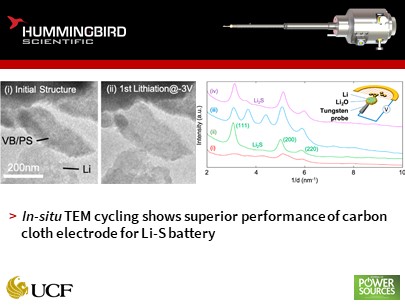Researchers from the University of Central Florida have recently demonstrated a new vat black/carbon cloth electrode for lithium-sulfur batteries. In-situ TEM cycling performed using Hummingbird Scientific’s TEM Biasing Manipulator holder showed the electrode undergo fast reaction but volume changes were minimal. The work published in the Journal of Power Sources shows the feasibility of using vat black/carbon electrodes for low-cost, high-energy lithium-sulfur batteries.

The nano battery setup for the work was designed using a TEM Biasing Manipulator holder. A small piece of metal attached to the mobile probe served as an anode. The vat black/carbon cathode electrode particles were dispersed on the half-cut TEM grid and affixed on the stationary end of the holder tip. The mobile Li probe was brought in contact with the cathode particles and constant voltages of -3V and +3V were applied during lithiation and delithiation, respectively. Similar work can be performed to test and validate many other electrodes for future battery applications.
Reference: Saisaban Fahad, Zhen Wei, and Akihiro Kushima. “In-situ TEM observation of fast and stable reaction of lithium polysulfide infiltrated carbon composite and its application as a lithium sulfur battery electrode for improved cycle lifetime,” Journal of Power Sources (2021). Full Paper
View All News

